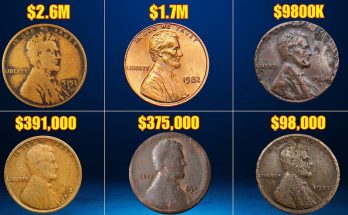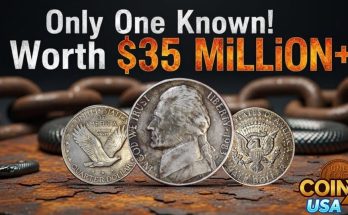💥 Debunking the Myth: The Real Value of the $259 Million Bicentennial Quarter
The image you provided, featuring the stunning 1776–1976 Bicentennial Quarter with a colossal price tag of “$259 Million USD,” captures the powerful appeal of numismatic sensationalism. This figure is a prime example of online exaggeration designed to be pure “clickbait” and does not reflect the coin’s actual market value. The Bicentennial Quarter is one of the most beloved commemorative coins in U.S. history, and while certain varieties are valuable, the real worth lies in understanding the difference between myth and certified rarity.
This description will first address and debunk the multi-million dollar claim, and then provide a comprehensive guide to the true value of the 1776–1976 Bicentennial Quarter, focusing on the specific characteristics that actually make these coins desirable to collectors.
The Bicentennial Quarter: A National Commemoration
To commemorate the 200th anniversary of the signing of the Declaration of Independence, the U.S. Mint issued the Bicentennial Quarter (along with a half dollar and dollar) for both 1975 and 1976. All coins struck during this period bear the dual date 1776–1976 on the obverse.
The reverse, designed by Jack L. Ahr, features a Colonial Drummer accompanied by a victory torch encircled by thirteen stars, representing the original colonies. This iconic design is what earned it the nickname the “Drummer Boy Quarter.” The sheer volume of production for this commemorative coin is the primary reason why common examples are not rare. The Philadelphia and Denver Mints struck over 1.6 billion copper-nickel clad Bicentennial Quarters for general circulation, ensuring that nearly every American received one.
Debunking the $259 Million Claim
The value of $259 Million USD is entirely baseless and has no foundation in documented auction sales or numismatic records. No circulating coin in U.S. history, not even the legendary 1913 Liberty Head Nickel (valued in the millions) or the 1943 Copper Cent (valued up to $2.6 million), has ever approached a nine-figure price. These exaggerated figures are frequently generated by unverified online sources or computer algorithms and should be disregarded by serious collectors.
The Real Value Guide: What to Look For
While common Bicentennial Quarters found in pocket change are typically worth only their 25-cent face value, there are three distinct categories that do carry a premium:
1. The 40% Silver Clad Variety (The True Rarities)
The most valuable standard issue of the Bicentennial Quarter is the one struck in 40% Silver. These coins were not released into general circulation and were exclusively sold by the U.S. Mint in special collector sets (Uncirculated and Proof sets).
-
How to Identify: The 40% silver coins were only minted in San Francisco and bear the “S” mint mark. They have a noticeably different appearance and a slightly higher weight (around 5.75 grams) than the standard copper-nickel clad coins (around 5.67 grams).
-
Actual Value: A circulated 40% Silver Quarter is typically worth a few dollars, largely based on its silver melt value. However, a pristine, Uncirculated (MS-65) example can trade for $7 to $25. The rarest silver Bicentennial Quarters—those certified in the highest known grades, such as MS-69—have achieved auction prices of up to $7,000 to $9,250, a substantial premium, but far from the million-dollar myth.
2. Mint Errors (The Collector’s Dream)
Like all U.S. coinage, errors that slipped past quality control can command high prices:
-
Doubled Die Errors (DDO/DDR): A documented doubled die on either the obverse (Washington’s portrait) or the reverse (Drummer Boy design) can significantly boost value. Strong, clear examples of a Bicentennial Doubled Die Reverse (DDR) have been known to sell for $200 to over $1,000, depending on the clarity and grade.
-
Wrong Planchet Errors: If a Bicentennial Quarter were accidentally struck on a planchet intended for another denomination (e.g., a dime or penny), it would be an extreme rarity worth tens of thousands of dollars, though none are commonly documented at that high a price.
3. High-Grade Perfection (The Premium for Condition)
For the vast majority of copper-nickel clad Bicentennial Quarters (marked with a ‘P’, ‘D’, or no mint mark), value is entirely dependent on condition, or grade.
-
Common Circulated: $0.25 to $1.00
-
Mint State (MS-65): $6 to $10
-
Exceptional Grade (MS-68 or higher): A near-perfect, flawlessly struck coin, virtually untouched by human hands, is incredibly rare for a circulating issue. These “Top Pop” certified coins, particularly from the Denver (‘D’) Mint, have reached auction prices as high as $3,750 to $4,988.
In summary, the 1776–1976 Bicentennial Quarter is a treasured piece of American history, but the true wealth it represents is measured in its historical significance, not a multi-million dollar price tag. A real-world valuable Bicentennial Quarter is one of the rare 40% silver issues, a pronounced mint error, or an extremely high-grade specimen.
Would you like me to focus on a specific genuine Bicentennial Quarter error, such as the Doubled Die Reverse, and provide tips on how to identify it?



